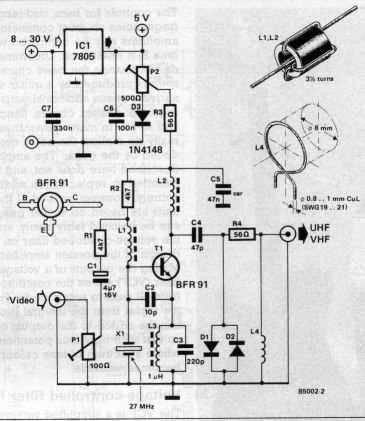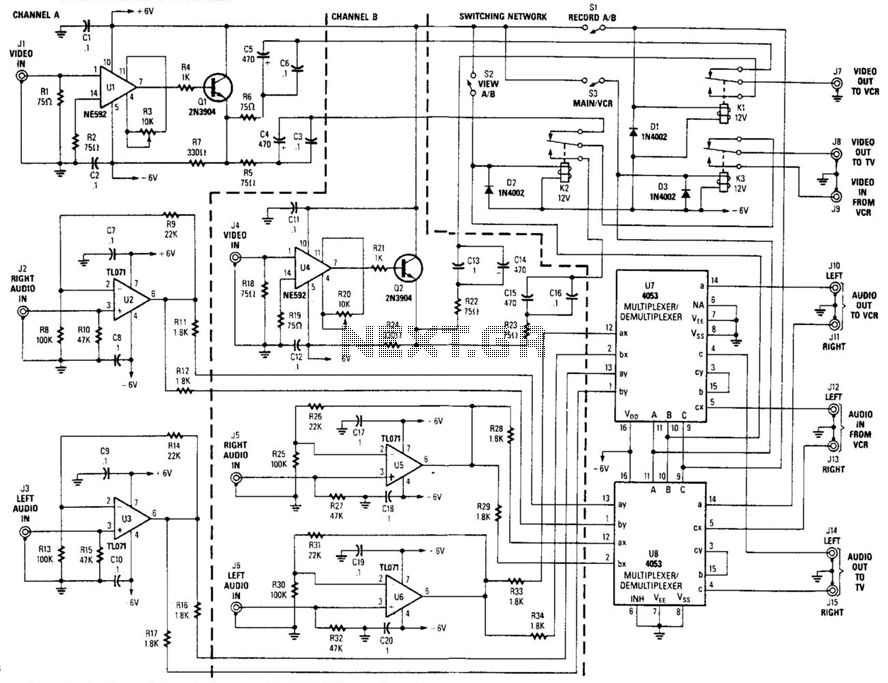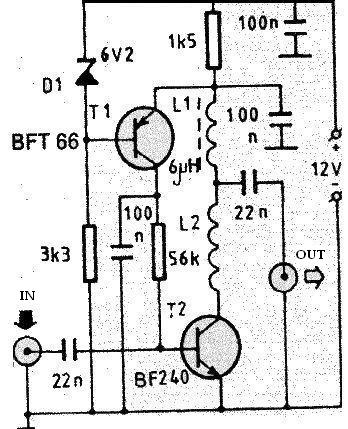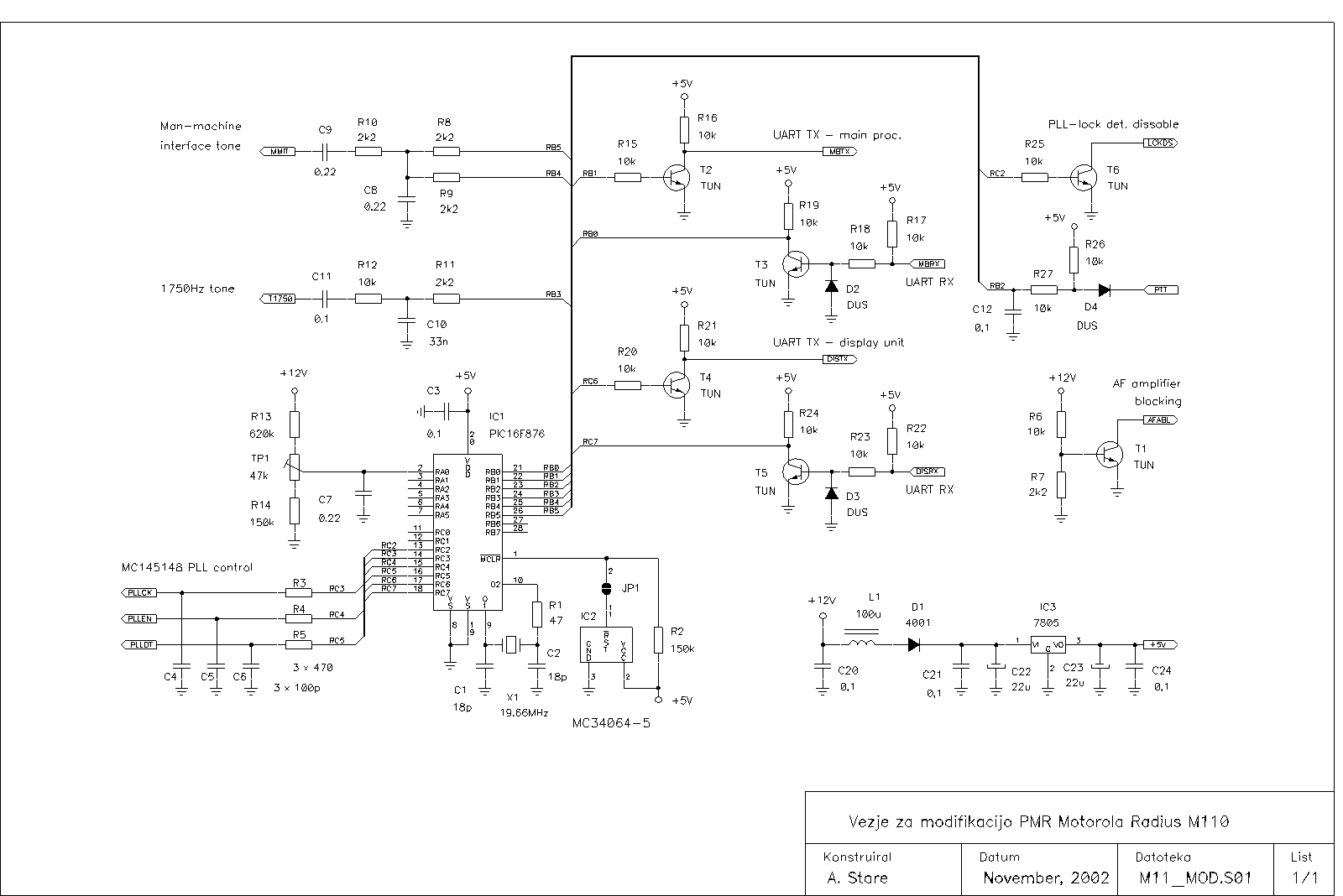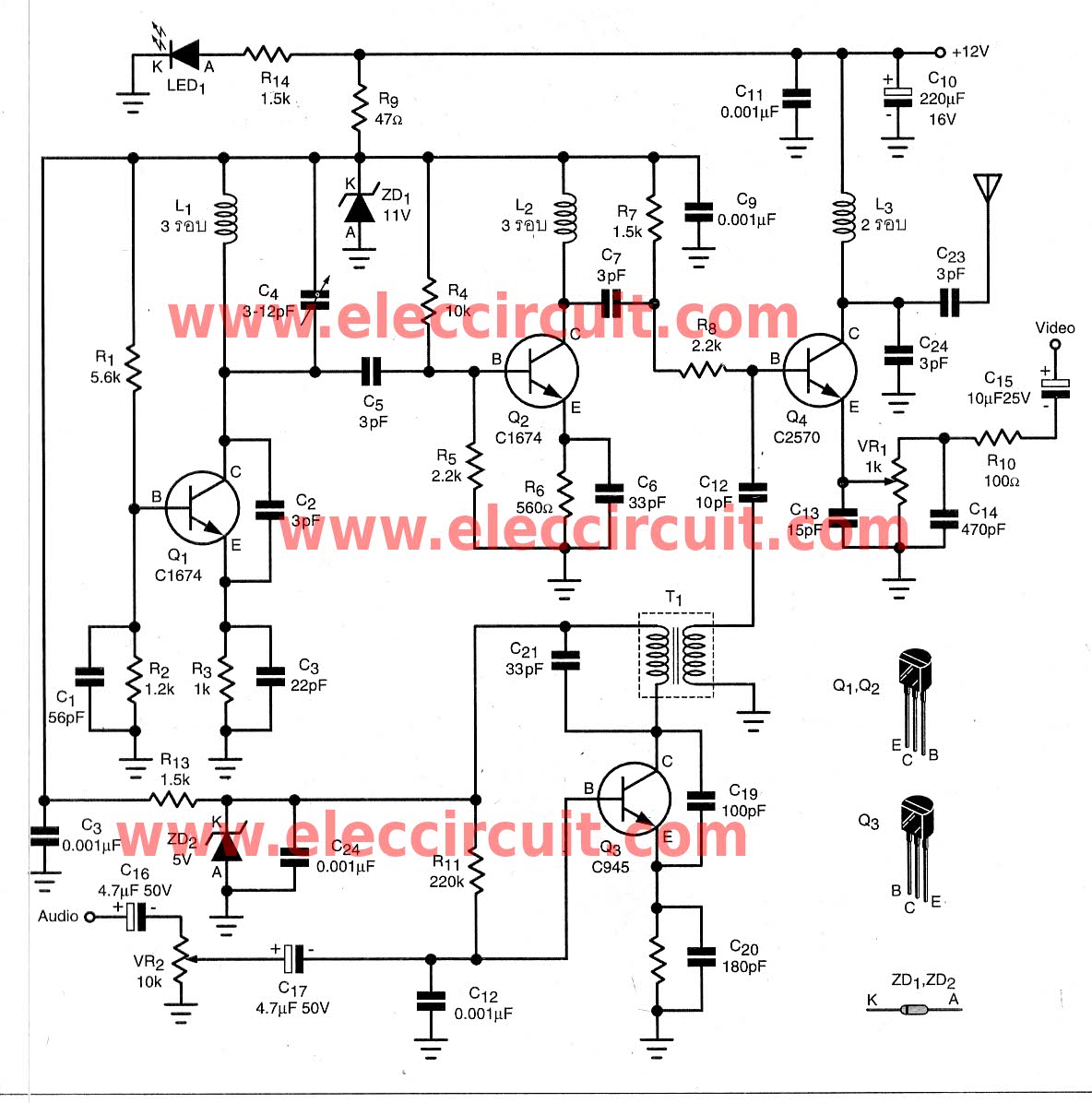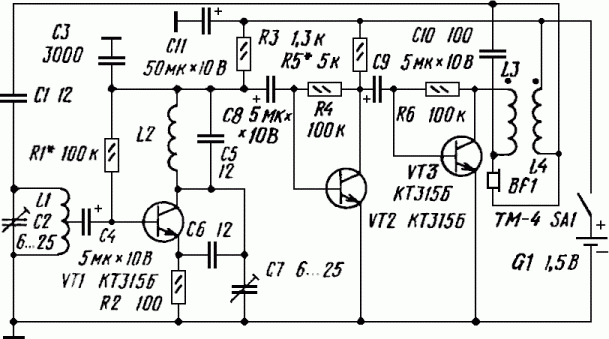
VHF Audio/Video Sender
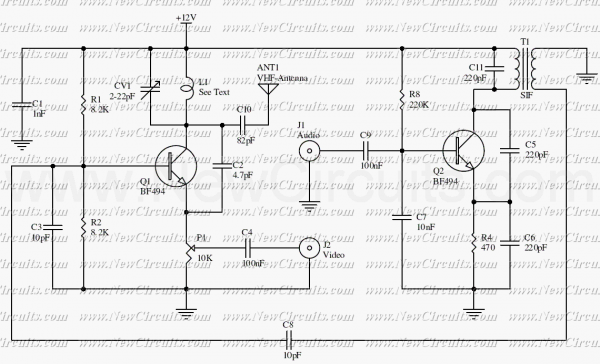
The circuit presented here is a simple audio/video transmitter with a range of 3 to 5 metres. The A/V signal source for the circuit may be a VCR, a satellite receiver or a video game etc. A mixer which also operates as an oscillator at VHF (H) channel 5 TV frequency is amplitude modulated by video signal and mixed with frequency mo enna, contains video carrier frequency of 175.25 Mhz and audio carrier frequency of 180.75 Mhz. Then, the transmitter is a B-System of CCIR compatible. More: The circuit consists of transistor Q1 with its resonant tuned tank circuit formed by inductor L1 and trimmer capacitor VC1, oscillating at VHF (H) channel 5 frequency. Transistor Q2 with its tuned circuit formed using SIF coil and inbuilt capacitor forms
The circuit described serves as a basic audio/video transmitter designed to operate within a range of 3 to 5 meters. The A/V signal source can include devices such as VCRs, satellite receivers, or video game consoles. The primary function of the circuit is to modulate the audio and video signals for transmission over VHF frequencies, specifically tuned to channel 5.
The circuit employs a mixer that doubles as an oscillator, which is crucial for generating the desired carrier frequencies. The video signal modulates the amplitude of the carrier wave, which operates at a frequency of 175.25 MHz for video and 180.75 MHz for audio. This modulation technique allows for the transmission of audio and video signals simultaneously, enabling the receiver to decode and reproduce the original signals accurately.
The transmitter utilizes a transistor, designated as Q1, which is integral to the oscillation process. Q1 is connected to a resonant tank circuit composed of inductor L1 and a variable capacitor (VC1). This combination allows for fine-tuning of the oscillator to ensure it operates at the precise frequency required for VHF channel 5. The resonant circuit's design is critical, as it determines the stability and quality of the transmitted signal.
Additionally, transistor Q2 is included in the design, which further enhances the circuit's performance. Q2 works in conjunction with a tuned circuit formed by a SIF coil and an inbuilt capacitor. This configuration aids in filtering and amplifying the modulated signals, ensuring that they maintain integrity over the transmission distance.
The overall design adheres to the B-System standards set by the CCIR (International Radio Consultative Committee), ensuring compatibility with other broadcasting equipment and receivers. This compatibility is essential for effective communication between the transmitter and various A/V devices, allowing for a seamless user experience.
In summary, the circuit is a compact and efficient audio/video transmitter that leverages VHF technology to deliver quality transmission over short distances while maintaining compatibility with standard broadcasting systems.The circuit presented here is a simple audio/video transmitter with a range of 3 to 5 metres. The A/V signal source for the circuit may be a VCR, a satellite receiver or a video game etc. A mixer which also operates as an oscillator at VHF (H) channel 5 TV frequency is amplitude modulated by video signal and mixed with frequency mo enna, contains video carrier frequency of 175.25 Mhz and audio carrier frequency of 180.75 Mhz. Then, the transmitter is a B-System of CCIR compatible. The circuit consists of transistor Q1 with its resonant tuned tank circuit formed by inductor L1 and trimmer capacitor VC1, oscillating at VHF (H) channel 5 frequency. Transistor Q2 with its tuned circuit formed using SIF coil and inbuilt capacitor forms 🔗 External reference
The circuit described serves as a basic audio/video transmitter designed to operate within a range of 3 to 5 meters. The A/V signal source can include devices such as VCRs, satellite receivers, or video game consoles. The primary function of the circuit is to modulate the audio and video signals for transmission over VHF frequencies, specifically tuned to channel 5.
The circuit employs a mixer that doubles as an oscillator, which is crucial for generating the desired carrier frequencies. The video signal modulates the amplitude of the carrier wave, which operates at a frequency of 175.25 MHz for video and 180.75 MHz for audio. This modulation technique allows for the transmission of audio and video signals simultaneously, enabling the receiver to decode and reproduce the original signals accurately.
The transmitter utilizes a transistor, designated as Q1, which is integral to the oscillation process. Q1 is connected to a resonant tank circuit composed of inductor L1 and a variable capacitor (VC1). This combination allows for fine-tuning of the oscillator to ensure it operates at the precise frequency required for VHF channel 5. The resonant circuit's design is critical, as it determines the stability and quality of the transmitted signal.
Additionally, transistor Q2 is included in the design, which further enhances the circuit's performance. Q2 works in conjunction with a tuned circuit formed by a SIF coil and an inbuilt capacitor. This configuration aids in filtering and amplifying the modulated signals, ensuring that they maintain integrity over the transmission distance.
The overall design adheres to the B-System standards set by the CCIR (International Radio Consultative Committee), ensuring compatibility with other broadcasting equipment and receivers. This compatibility is essential for effective communication between the transmitter and various A/V devices, allowing for a seamless user experience.
In summary, the circuit is a compact and efficient audio/video transmitter that leverages VHF technology to deliver quality transmission over short distances while maintaining compatibility with standard broadcasting systems.The circuit presented here is a simple audio/video transmitter with a range of 3 to 5 metres. The A/V signal source for the circuit may be a VCR, a satellite receiver or a video game etc. A mixer which also operates as an oscillator at VHF (H) channel 5 TV frequency is amplitude modulated by video signal and mixed with frequency mo enna, contains video carrier frequency of 175.25 Mhz and audio carrier frequency of 180.75 Mhz. Then, the transmitter is a B-System of CCIR compatible. The circuit consists of transistor Q1 with its resonant tuned tank circuit formed by inductor L1 and trimmer capacitor VC1, oscillating at VHF (H) channel 5 frequency. Transistor Q2 with its tuned circuit formed using SIF coil and inbuilt capacitor forms 🔗 External reference
Warning: include(partials/cookie-banner.php): Failed to open stream: Permission denied in /var/www/html/nextgr/view-circuit.php on line 713
Warning: include(): Failed opening 'partials/cookie-banner.php' for inclusion (include_path='.:/usr/share/php') in /var/www/html/nextgr/view-circuit.php on line 713
